You’ve probably heard of most of the languages we teach on Duolingo—Spanish, Japanese, and Swahili, to name a few. But certain languages Duolingo teaches didn’t exist 150 (or even 25) years ago. These are the constructed language (or “conlang”) courses—Klingon, High Valyrian, and Esperanto. Unless you’re binging Game of Thrones or Star Trek, you’re probably not hearing these languages being used day to day. So why study a language that someone else made up? In short, because it’s fun! Learning a conlang can connect you to a community of people with similar interests, and can also help you learn about language.
 |
 |
 |
What is a “conlang”?
Conlangs, a term that comes from “constructed languages,” are languages that someone intentionally created. There are many reasons to create a conlang, including to facilitate communication between speakers of different languages (check out Volapük) or even to reflect aesthetic and philosophical principles (Toki Pona was designed for minimalism and positive thinking). Some of the best known (although not yet widely spoken!) conlangs were created as part of world-building for media and entertainment, including Klingon for Star Trek and Dothraki and Valyrian for Game of Thrones.
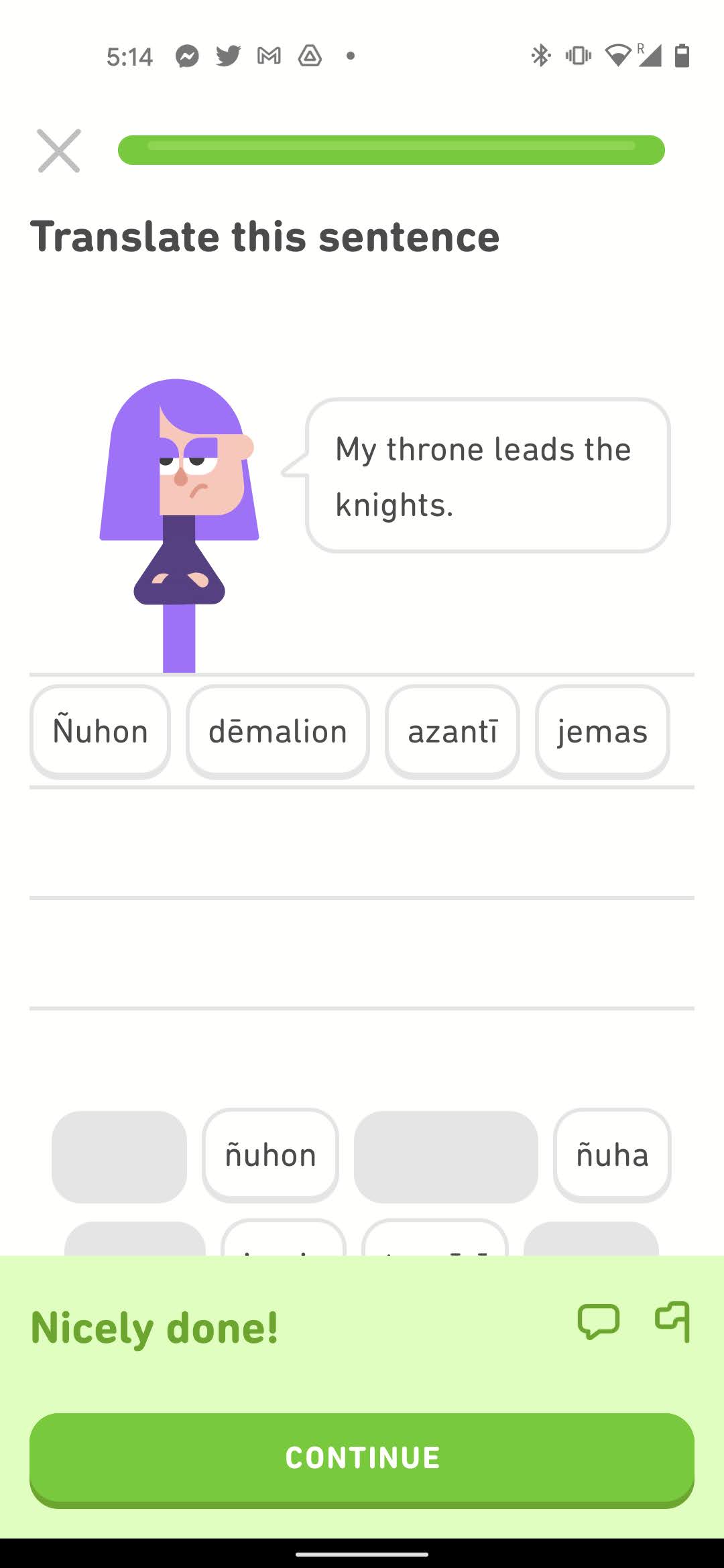 |
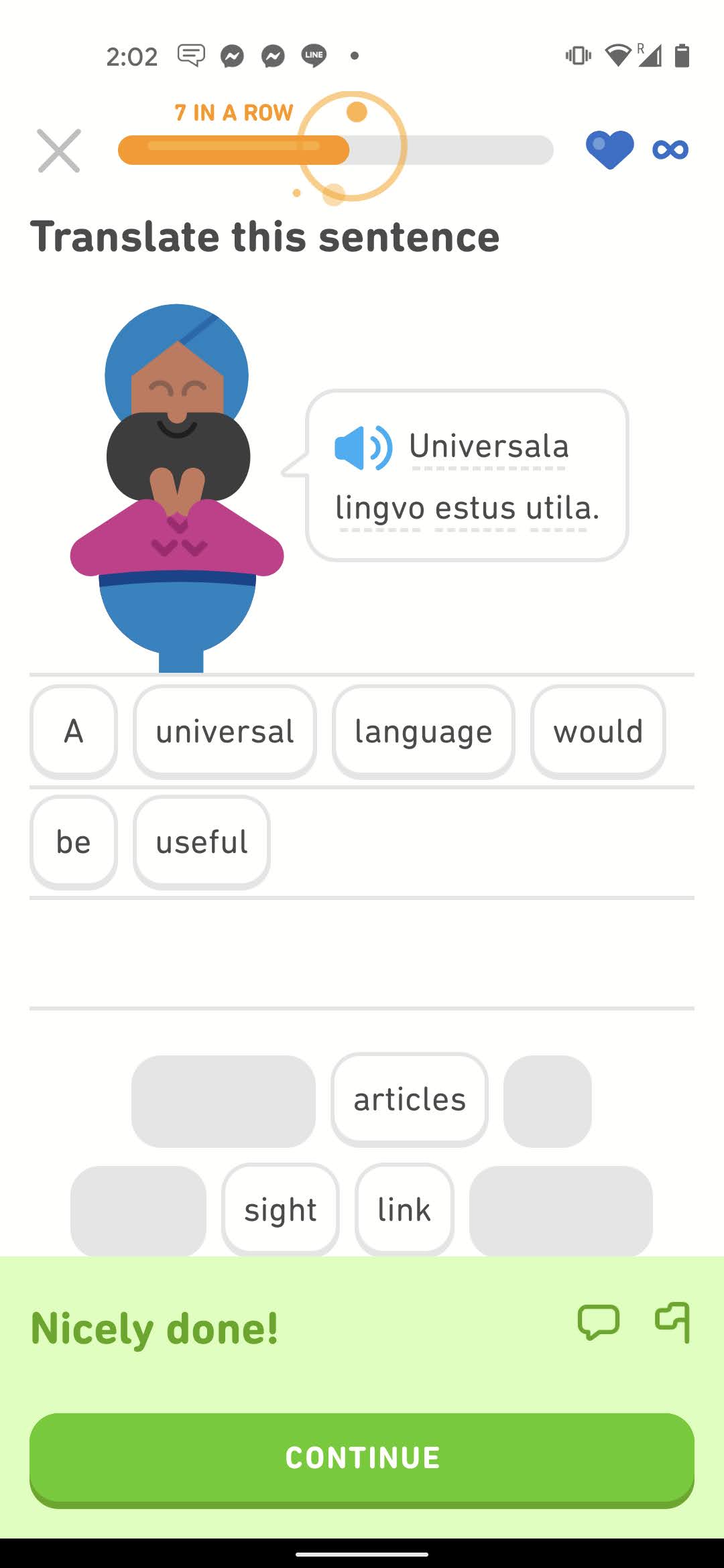 |
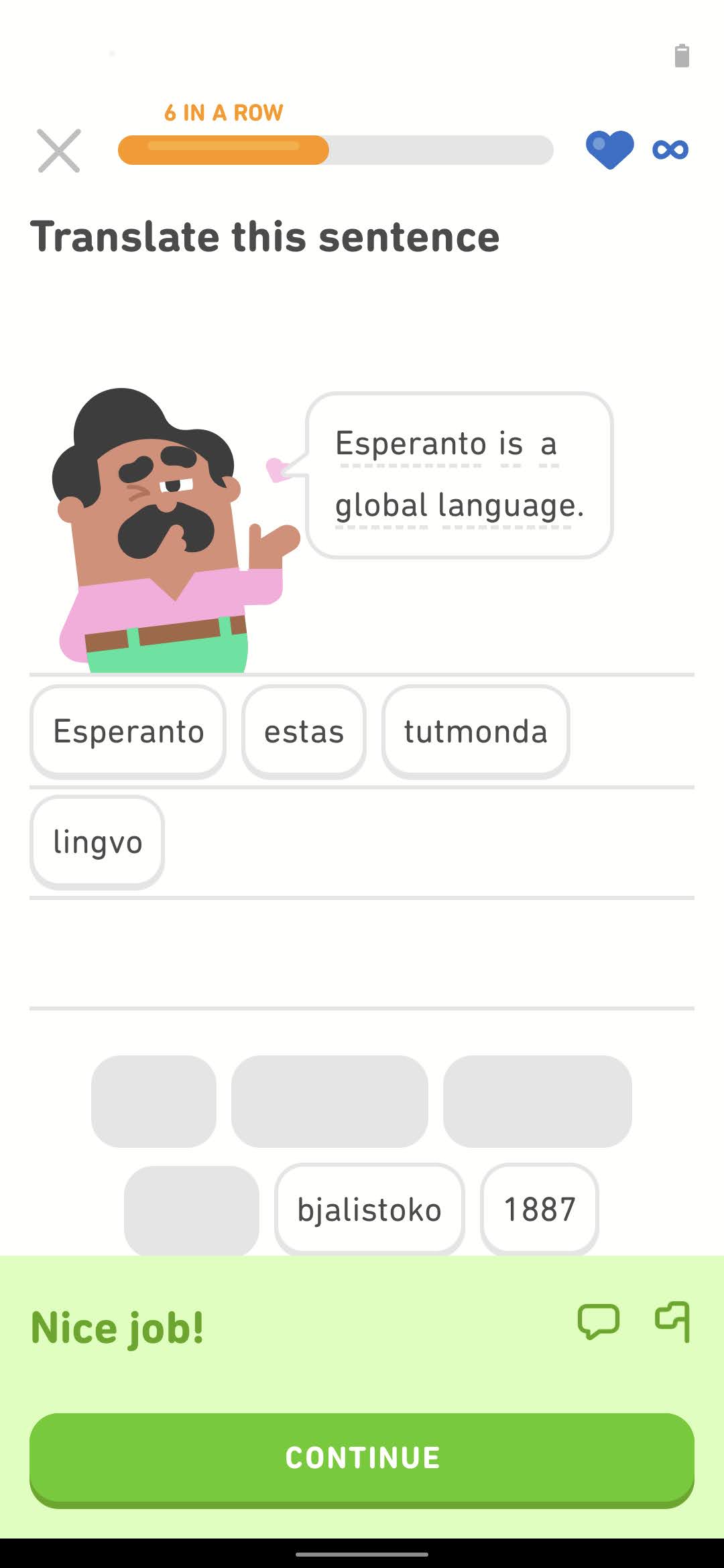 |
Conlang creators don’t just make up a bunch of words—they think about how those words will be pronounced, used in different contexts, and combined to form sentences. They also design languages with specific aesthetics in mind. For Star Trek, Klingon was meant to sound unusual and harsh, as the language of an aggressive alien species. On the other hand, David J. Peterson, the creator of both Game of Thrones languages and the High Valyrian Duolingo course, stated that High Valyrian was made to sound “pretty” and “magisterial,” since it is the classical language of an ancient civilization. Dothraki, the language of another Game of Thrones culture, needed to fit the image of a rugged, nomadic people.
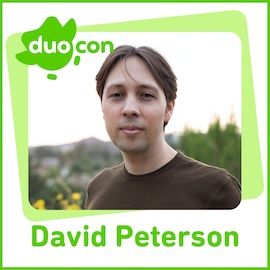
Esperanto is one of the most successful conlangs: it has the largest conlang edition of Wikipedia, and Esperanto Wikipedia is the 35th largest among all languages! It, too, was designed for particular communication purposes and with deliberate goals. Esperanto’s creator, L.L. Zamenhof, gave Esperanto completely regular spelling, based its vocabulary on words shared across European languages, and designed the grammar to be entirely systematic and straightforward. For example, there are no grammatical genders, all nouns end in -o, and all verbs conjugate the same way regardless of who you’re talking about (see the table below for an example).
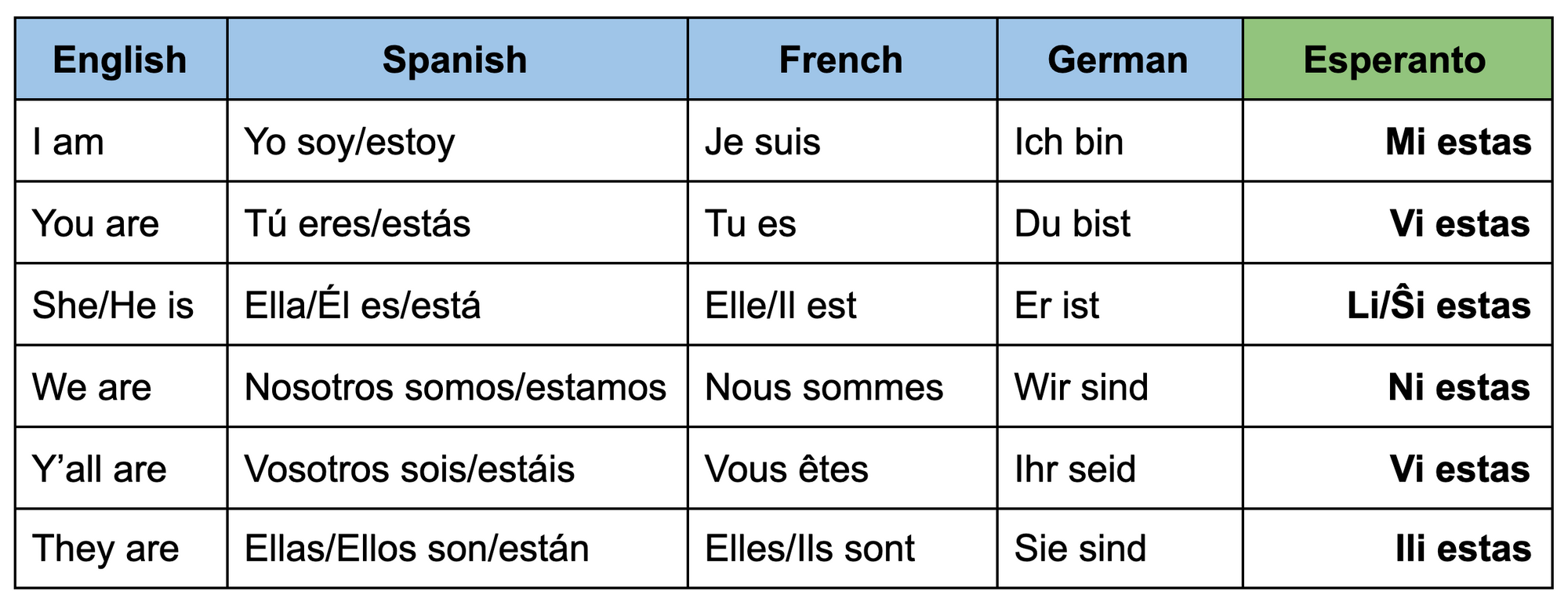
Why learn a conlang?
Just like there are numerous reasons to create a conlang, there are at least as many reasons to learn one. People in conlang communities are eager to connect and communicate with each other about the topics they love, just like all language learners! Fans of a fiction franchise like Star Trek or Game of Thrones might learn a language from that fictional universe in order to engage more deeply with the stories they love—like the Comic Con attendee who asked Jason Momoa a question in Dothraki! You can also find conlang enthusiasts practicing together at Star Trek conventions, through the Klingon Language Institute, and even with Duolingo Events. In 2020, Duolingo Events hosted over 1,000 Esperanto language exchanges! Maybe one day you can spend a whole week speaking Esperanto at the annual World Esperanto Congress.
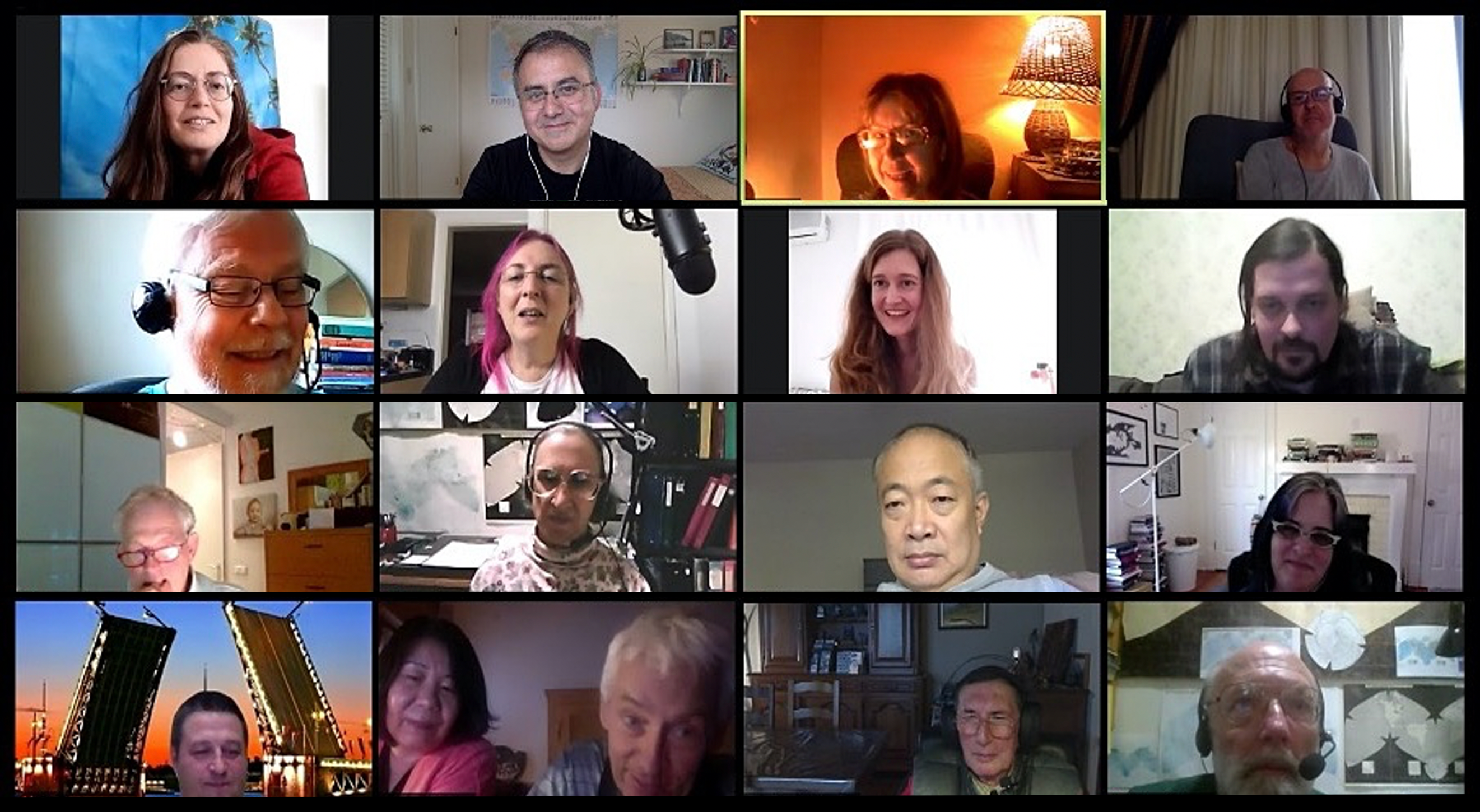
Learners of conlangs also use their languages to express themselves creatively. Esperantists have developed a wealth of original and translated Esperanto literature. Just like books, plays, and movies allow us to imagine fictional realities and explore human nature, conlangs allow learners to imagine fictional cultures and explore the possibilities of humanity’s future.
In addition to fun and socializing, there are practical reasons to learn a conlang. Studying any language can help you develop metalinguistic awareness—the ability to consciously think about different properties of a language such as pronunciation and grammar. Since some conlangs are designed to be easy to learn, they can give you the language-learning experience with fewer grammatical headaches (like you saw earlier in the verb table). Many Esperanto learners report feeling more success and confidence in their language-learning abilities, especially if they had previously struggled with other languages.
Because of their unusual origins, new conlang courses are attention-grabbing events that can attract the interest of lots of would-be language learners. It’s no wonder that 43% of Duolingo users who join to study a conlang go on to study another language on Duolingo. And as more people find out about Duolingo and the number of Duolingo learners grows, Duolingo can invest more in the development of new courses and features for everyone.
Now what?
See what all the conlang enthusiasts are so excited about! Is Esperanto really that easy to learn? How much more exciting is Game of Thrones when you can understand High Valyrian? To find out, check out the Esperanto, High Valyrian, and Klingon courses on Duolingo! Bonan lernadon and wo’ batlhvaD!
Kial lerni elpensitan lingvon?
Vi verŝajne konas la plej multajn lingvojn, kiujn ni instruas ĉe Duolingo—la hispana, japana, kaj svahila, por mencii kelkajn. Sed iuj el la lingvoj instruataj per Duolingo ne ekzistis antaŭ 150 (aŭ eĉ 25) jaroj. Ĉi tiuj estas la planlingvaj (angle “conlang”) kursoj—la klingona, alta valiria, kaj Esperanto. Krom se vi diboĉspektas Ludo de Tronoj aŭ Star Trek, vi verŝajne ne aŭdas ĉi tiujn lingvojn ĉiutage. Kial do studi lingvon, kiun kreis aliulo? Unuvorte, ĉar estas amuze! Lerni planlingvon povas kunligi vin kun komunumo de homoj kun similaj interesoj, kaj ankaŭ povas helpi vin lerni pri lingvo ĝenerale.
Kion signifas “planlingvo”?
Planlingvoj, kunmetaĵo de “plano” kaj “lingvo”, estas lingvoj, kiujn iu kreis intence. Estas multaj kialoj krei planlingvon, inkluzive de faciligi la komunikadon inter parolantoj de malsamaj naturaj lingvoj (ekzemple Volapuko aŭ eĉ reflekti estetikajn kaj filozofiajn principojn (Tokipono estis kreita por minimumismo kaj pozitiva pensado). Kelkaj el la plej konataj (kvankam ankoraŭ ne multe parolataj!) planlingvoj estis kreitaj kadre de mondkonstruado por televidserioj kaj filmoj, inkluzive de la klingona por Star Trek kaj la dotraka kaj la valiria por Ludo de Tronoj.
Kreintoj de planlingvoj ne nur elpensas aron da vortoj—ili ankaŭ devas pripensi, kiel tiuj vortoj estos prononcataj, uzataj en diversaj kuntekstoj, kaj kunmetataj por formi frazojn. Ili ankaŭ kreas lingvojn celante specifajn estetikojn. Por Star Trek, la klingona celis soni nekutime kaj severe, kiel la lingvo de agresema fremda specio. Aliflanke, David Peterson, la kreinto de ambaŭ lingvoj de Ludo de Tronoj, diris ke li igis la altvalirian soni “bele” kaj “majeste”, ĉar ĝi estas la klasika lingvo de antikva civilizacio. La dotraka, lingvo de alia kulturo en Ludo de Tronoj, devis taŭgi la imagon de kruda nomada popolo.
Esperanto estas unu el la plej sukcesaj planlingvoj: ĝi havas la plej grandan planlingvan eldonon de Vikipedio, kaj Esperanta Vikipedio estas la 35a plej granda inter ĉiuj lingvoj! Ankaŭ ĝi estis projektita por apartaj komunikaj uzoj kaj kun konsciaj celoj. La kreinto de Esperanto, L.L. Zamenhof, donis al Esperanto tute regulan literumon, bazis ĝian vortprovizon sur vortradikoj komunaj tra eŭropaj lingvoj, kaj desegnis la gramatikon por esti tute regula kaj simpla. Ekzemple, ne ekzistas gramatikaj genroj, ĉiuj substantivoj finiĝas per -o, kaj ĉiuj verboj konjugiĝas same sendepende de kiu vi parolas.
Kial lerni planlingvon?
Same kiel ekzistas multaj kialoj por krei planlingvon, ekzistas almenaŭ tiom da kialoj por lerni iun. Planlingvaj komunumanoj avidas kunligiĝi kaj interkompreniĝi pri la temojn, kiujn ili amas, same kiel ĉiuj lingvolernantoj! Fanatikuloj de fikcia serio kiel Star Trek aŭ Ludo de Tronoj povus lerni lingvon de tiu fikcia universo por konektiĝi pli profunde kun la rakontoj, kiujn ili amas—kiel la ĉeestanto de Comic Con, kiu faris demandon al Jason Momoa dotrake! Vi ankaŭ povas trovi planlingvajn entuziasmulojn interparolantajn kune ĉe kongresoj de Star Trek, tra la Klingonlingva Instituto, kaj eĉ per Duolingo-Eventoj. En 2020, Duolingo-Eventoj okazigis pli ol 1,000 esperantlingvajn interŝanĝojn! Rigardu venontajn Duolingo-Eventojn (aŭ kandidatiĝu por konduki viajn proprajn), kaj eble iam vi povos pasigi tutan semajnon parolante Esperanton ĉe la ĉiujara Universala Kongreso de Esperanto.
Lernantoj de planlingvoj ankaŭ uzas siajn lingvojn por esprimi sin kreeme. Esperantistoj jam disvolvis abundan originalan kaj tradukitan esperantan literaturon. Samkiel libroj, teatraĵoj kaj filmoj permesas al ni imagi fikciajn realojn kaj esplori la homan naturon, planlingvoj permesas al lernantoj imagi fikciajn kulturojn kaj esplori la eblojn de la homara estonteco.
Krom amuziĝo kaj societumado, ekzistas praktikaj utiloj de lerni planlingvon. Studi iun ajn lingvon povas helpi al vi disvolvi metalingvan konscion—la kapablon konscie pensi pri diversaj ecoj de lingvo, kiel elparolado kaj gramatiko. Ĉar iuj planlingvoj estas desegnitaj por esti facile lernebla, ili havigas al vi la lingvolernan sperton kun malpli da kapdolorigaj gramatikaĵoj. Multaj Esperanto-lernantoj raportas pli grandan senton de sukceso kaj memfido pri siaj lingvolernaj kapabloj, precipe se ili antaŭe luktis lerni aliajn lingvojn.
Pro iliaj nekutimaj devenoj, novaj planlingvaj kursoj estas atentokaptaj okazoj, kiuj povas altiri la intereson de multaj estontaj lingvolernantoj. Ne mirinde, ke 43% de Duolingo-uzantoj, kiuj aliĝas por studi planlingvon, sekve studas alian lingvon pri Duolingo. Kaj ju pli da homoj ekscias pri Duolingo kaj la nombro de lernantoj sur Duolingo plimultiĝas, des pli multe Duolingo povas investi en la disvolviĝo de novaj kursoj kaj funkcioj por ĉiuj.
Nun kion?
Malkovru pri kio ĉiuj planlingvaj entuziasmuloj tiel ekscitiĝas! Ĉu Esperanto vere estas tiel facile lernebla? Kiom pli ekscita estas Ludo de Tronoj kiam vi povas kompreni la altvalirian? Por sciiĝi, provu la kursojn Esperantan, altvalirian, kaj klingonan sur Duolingo! Valar gūrēñis kaj wo’ batlhvaD!
